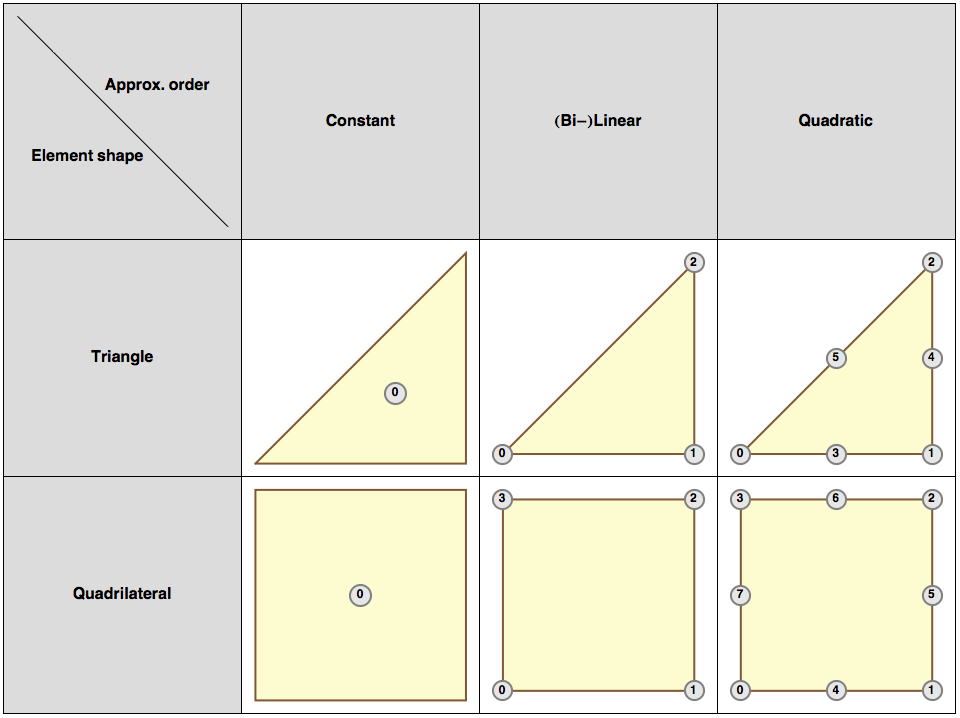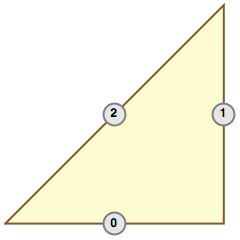BETL creates finite element spaces by exploiting two independent
information sources. On one hand the topological data is needed. This
data is either provided via the Mesh class or via some intermediate
structure which extracts a certain surface patch from the mesh. On the
other hand we need some information about the basis a particular finite
element space corresponds to. This information is provided by the
FEBasis class. This section will be
roughly divided into two parts. At first, we will deal with a proper
definition of the FEBasis. Afterwards, the
DoFHandler will be introduced. This
class is of fundamental importance since it combines the topological
information with the information about the FE space's basis. Hence, this
class actually spans the finite element space.
For the definition of the finite element space's basis the following information is needed:
The element type
The approximation order
The continuity of the discrete space
A main category the finite element space belongs to
Let's start from the back with the explanation of these items. Finite Element spaces are classified by categories or families of functions. These families subsume unique properties of the corresponding space. So far the BETL provides two fundamentally different families. The first one corresponds probably to the most common class of FE spaces. It is the family of Lagrangian or hat basis functions. These functions feature the well-known property
where
is the function corresponding to the
local dof,
is the location of the
local dof and
is the Kronecker symbol. Those functions are well suited for classical
potential problems as well as for problems in acoustics. Another
fundamental family is known as the family of edge
functions. For instance, these functions are important for the
discretisation of of Maxwell's equations. In BETL the Lagrangian
functions are specified by the structure
LagrangeTraits while the edge functions
are either specified by EdgeDivTraits or by
EdgeCurlTraits,
respectively. Both, the EdgeDivTraits as well
as the EdgeCurlTraits are edge functions. The
only difference is that the latter contains the rotated functions of
the former. Mathematically, this means that if
belongs to the space of functions where the surface divergence is square
integrable, that
belongs to the space of functions whose surface curls are square
integrable. The connection between these functions is given by the
rotation operator
such that
. In Equation 2.2
is simply the outward normal vector.
The third item from the enumeration above describes how the
degrees of freedom (dofs) will be distributed. For
instance, a dof lying on an edge or on a corner of an element could be
shared by all of its neighbouring elements or it may be exclusively
attached to the current element. Within BETL, the first scenario is
determined by the Continuous type and the second one
is defined by the Discontinuous type. The decision
whether the dofs might be distributed continuously or discontinuously
might not be necessarily a property of the
FEBasis. The decision is made herein because of
the somehow famous “historical reasons”. The
continuous/discontinuous dof distribution has been always a part of the
FEBasis. That's it. Nevertheless, this may
change in future versions of the BETL.
Let's go ahead. The second item from the enumeration describes the order of a
function, i.e., whether the function might be constant, linear,
quadratic, or of some higher order. For functions that belong to the
Lagrangian family BETL implements constant, linear, and quadratic
functions. Contrary, edge-functions are only implemented at
lowest-order, i.e., currently only linear edge-functions are
supported. The choice of the approximation order is made by the
APPROX_ORDER enum.
The one item that is left is the first one from the enumeration. With this, one simply
determines the general shape of an element, i.e., whether it is a
triangle or a quadrilateral. Here, “general shape” means
that the geometrical approximation of an element is by no means
considered. Since the FEBasis is independent of
any topological information it could be defined either on a flat or on a
curved geometry approximation.
Now, since the description of the FEBasis is
finished we can give some examples on how this data type is actually
constructed.
Example 2.1. Possible finite element basis declarations
#include "febasis/febasis.hpp"
using namespace betl;
// lowest order lagrangian functions on flat triangles
typedef FEBasis< Element<3>,
CONSTANT,
Discontinuous,
LagrangeTraits > feb_e3_const_disc_lagr_t;
// lowest order divergence functions on flat triangles
typedef FEBasis< Element<3>,
LINEAR,
Continuous,
EdgeDivTraits > feb_e3_lin_cont_div_t;
// quadratic, continuous functions on flat quadrilaterals
typedef FEBasis< Element<4>,
QUADRATIC,
Continuous,
LagrangeTraits > feb_e4_quad_cont_lagr_t;
// linear, discontinuous functions on curved triangles
typedef FEBasis< Element<6>,
LINEAR,
Discontinuous,
LagrangeTraits > feb_e6_lin_disc_lagr_t;
While Example 2.1, “Possible finite element basis declarations” depicts the possible choices
for a finite element basis there exist also some combinations which are
not allowed. Using these combinations within your code yields in rather
crucial compiler errors.
Example 2.2. Impossible finite element basis declarations
#include "febasis/febasis.hpp"
using namespace betl;
// ERROR: a constant function can't be approximated continuously
typedef FEBasis< Element<3>,
CONSTANT,
Continuous,
LagrangeTraits > feb_e3_const_cont_lagr_t;
// ERROR: constant edge functions do not exist
typedef FEBasis< Element<3>,
CONSTANT,
Discontinuous,
EdgeCurlTraits > feb_e3_const_disc_curl_t;
// ERROR: higher order divergence functions are not implementd right now
typedef FEBasis< Element<3>,
QUADRATIC,
Continuous,
EdgeDivTraits > feb_e3_quad_cont_div_t;
// ERROR: edge functions are only implemented for triangles
typedef FEBasis< Element<4>,
LINEAR,
Continuous,
EdgeDivTraits > feb_e4_lin_cont_div_t;
Note that the first and second forbidden combinations in Example 2.2, “Impossible finite element basis declarations” are disallowed due to logical
considerations while the two latter combinations are disallowed because
of a lack of implementation. In future versions of BETL there might
exist higher order edge functions and there might also exist edge
functions for quadrilaterals.
In Figure 2.1, “Supported Lagrangian bases”, the possible choices
for Lagrangian based spaces as well as their local dof-numbering are
depicted. Additionally, Figure 2.2, “Supported edge basis” shows
the local dof distribution for the currently implemented edge bases.
For completeness, the following formula defines the lowest order edge
functions for the
space
where
denotes the Gram determinant of the element
and
is the triangle's
vertex lying opposite to the edge
.
Once the FEBasis has been defined the creation
of the finite element space is a quite easy task. As it has been
already said at the beginning of this section the finite element space
is spanned by an object called DoFHandler. This
data type combines the bases of the finite element space with the
topological information. The following example illustrates the
declaration and instantiation of the DoFHandler
Example 2.3. A possible dof handler declaration
#include "febasis/febasis.hpp"
#include "dof_handler/dof_handler.hpp"
using namespace betl;
// lowest order lagrangian functions on flat triangles
typedef FEBasis< Element<3>,
CONSTANT,
Discontinuous,
LagrangeTraits > feb_e3_const_disc_lagr_t;
// declare the dof handler data type
typedef DoFHandler< feb_e3_const_disc_lagr_t > dofhandler_t;
// instantiate the dofhandler
dofhandler_t dofhandler;
// span the finite element space
dofhandler.distributeDoFs( mesh.e_begin(), mesh.e_end() );
In Example 2.3, “A possible dof handler declaration” the mesh object
has not been declared but one might deduce that this variable
represents the mesh on which the analysis will take place. Moreover,
the creation of the finite element space's basis has been directly
taken from Example 2.1, “Possible finite element basis declarations”. As you see the
creation of the finite element step involves three steps:
Declare the dof handler type
Instantiate the dof handler object
Distribute the dofs by providing two forward iterators to a range of elements
Please refer to the section called “Example 2: The DofHandler concept” for an example about the usage of the dof handler.

